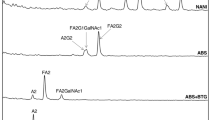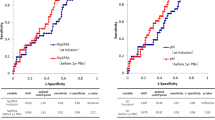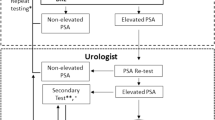Abstract
Background
Altered prostate-specific antigen (PSA) glycosylation patterns can be useful biomarkers in detecting high-grade prostate cancer (HGPC). The microfluidic immunoassay system can analyse α2,3-linked sialylated PSA (α2,3-Sia-PSA) and α1,6-linked fucosylated PSA (α1,6-Fuc-PSA) using different lectins, Mackkia amurensis agglutinin and Pholiota squarrosa lectin, respectively. Here, we investigated the diagnostic value of simultaneous analysis of α2,3-Sia-PSA and α1,6-Fuc-PSA for the detection of HGPC.
Methods
Men with serum PSA levels of 4–20 ng/mL who underwent prostate biopsy were included. The model to predict HGPC (Gleason grade ≥2) was constructed by multivariate logistic regression analysis, in combination with α2,3-Sia-PSA and α1,6-Fuc-PSA (SF index).
Results
In the development cohort (n = 150), the SF index showed good discrimination for HGPC (area under the receiver-operating curve (AUC) 0.842; 95% confidence interval (CI) 0.782–0.903), compared to the single PSA test (AUC 0.632, 95% CI 0.543–0.721), α2,3-Sia-PSA (AUC 0.711, 95% CI 0.629–0.793) and α1,6-Fuc-PSA (AUC 0.738, 95% CI 0.657–0.819). Decision-curve analysis showed the superior benefit of the SF index. In the validation cohort (n = 57), the SF index showed good discrimination for HGPC (AUC 0.769, 95% CI 0.643–0.895).
Conclusions
The SF index could differentiate HGPC, providing useful information for decision making for prostate biopsy in men with abnormal PSA levels.
This is a preview of subscription content, access via your institution
Access options
Subscribe to this journal
Receive 24 print issues and online access
$259.00 per year
only $10.79 per issue
Buy this article
- Purchase on SpringerLink
- Instant access to full article PDF
Prices may be subject to local taxes which are calculated during checkout



Similar content being viewed by others
References
Martin RM, Donovan JL, Turner EL, Metcalfe C, Young GJ, Walsh EI, et al. Effect of a low-intensity PSA-based screening intervention on prostate cancer mortality: the CAP Randomized Clinical Trial. JAMA. 2018;319:883–95.
Parekh DJ, Punnen S, Sjoberg DD, Asroff SW, Bailen JL, Cochran JS, et al. A multi-institutional prospective trial in the USA confirms that the 4Kscore accurately identifies men with high-grade prostate cancer. Eur Urol. 2015;68:464–70.
Loeb S, Sanda MG, Broyles DL, Shin SS, Bangma CH, Wei JT, et al. The prostate health index selectively identifies clinically significant prostate cancer. J Urol. 2015;193:1163–9.
Nordström T, Vickers A, Assel M, Lilja H, Grönberg H, Eklund M. Comparison between the four-kallikrein panel and prostate health index for predicting prostate cancer. Eur Urol. 2015;68:139–46.
Munkley J, Mills IG, Elliott DJ. The role of glycans in the development and progression of prostate cancer. Nat Rev Urol. 2016;13:324–33.
Scott E, Munkley J. Glycans as biomarkers in prostate cancer. Int J Mol Sci. 2019;20:1389.
Gilgunn S, Conroy PJ, Saldova R, Rudd PM, O’Kennedy RJ. Aberrant PSA glycosylation-a sweet predictor of prostate cancer. Nat Rev Urol. 2013;10:99–107.
Ohyama C, Hosono M, Nitta K, Oh-eda M, Yoshikawa K, Habuchi T, et al. Carbohydrate structure and differential binding of prostate specific antigen to Maackia amurensis lectin between prostate cancer and benign prostate hypertrophy. Glycobiology. 2004;14:671–9.
Tajiri M, Ohyama C, Wada Y. Oligosaccharide profiles of the prostate specific antigen in free and complexed forms from the prostate cancer patient serum and in seminal plasma: a glycopeptide approach. Glycobiology. 2008;18:2–8.
Yoneyama T, Ohyama C, Hatakeyama S, Narita S, Habuchi T, Koie T, et al. Measurement of aberrant glycosylation of prostate specific antigen can improve specificity in early detection of prostate cancer. Biochem Biophys Res Commun. 2014;448:390–6.
Pihikova D, Kasak P, Kubanikova P, Sokol R, Tkac J. Aberrant sialylation of a prostate-specific antigen: Electrochemical label-free glycoprofiling in prostate cancer serum samples. Anal Chim Acta. 2016;934:72–79.
Ferrer-Batallé M, Llop E, Ramírez M, Aleixandre RN, Saez M, Comet J, et al. Comparative study of blood-based biomarkers, α2,3-sialic acid PSA and PHI, for high-risk prostate cancer detection. Int J Mol Sci. 2017;18:845.
Fukushima K, Satoh T, Baba S, Yamashita K. Alpha1,2-fucosylated and beta-N-acetylgalactosaminylated prostate-specific antigen as an efficient marker of prostatic cancer. Glycobiology. 2010;20:452–60.
Dwek MV, Jenks A, Leathem AJ. A sensitive assay to measure biomarker glycosylation demonstrates increased fucosylation of prostate specific antigen (PSA) in patients with prostate cancer compared with benign prostatic hyperplasia. Clin Chim Acta. 2010;411:1935–9.
Li QK, Chen L, Ao MH, Chiu JH, Zhang Z, Zhang H, et al. Serum fucosylated prostate-specific antigen (PSA) improves the differentiation of aggressive from non-aggressive prostate cancers. Theranostics. 2015;5:267–76.
Gratacós-Mulleras A, Duran A, Asadi, Shehni A, Ferrer-Batallé M, Ramírez M, et al. Characterisation of the main PSA glycoforms in aggressive prostate cancer. Sci Rep. 2020;10:18974.
Ishikawa T, Yoneyama T, Tobisawa Y, Hatakeyama S, Kurosawa T, Nakamura K, et al. An automated micro-total immunoassay system for measuring cancer-associated α2,3-linked sialyl N-glycan-carrying prostate-specific antigen may improve the accuracy of prostate cancer diagnosis. Int J Mol Sci. 2017;18:470.
Rubén LC, Laura MR, Almudena FB, Emilio GM. Glycan array analysis of Pholiota squarrosa lectin and other fucose-oriented lectins. Glycobiology. 2021;31:459–76.
Fujita K, Hatano K, Tomiyama E, Hayashi Y, Matsushita M, Tsuchiya M, et al. Serum core-type fucosylated prostate-specific antigen index for the detection of high-risk prostate cancer. Int J Cancer. 2021;148:3111–8.
Meany DL, Zhang Z, Sokoll LJ, Zhang H, Chan DW. Glycoproteomics for prostate cancer detection: changes in serum PSA glycosylation patterns. J Proteome Res. 2009;8:613–9.
Stenman UH, Leinonen J, Alfthan H, Rannikko S, Tuhkanen K, Alfthan O. A complex between prostate-specific antigen and alpha 1-antichymotrypsin is the major form of prostate-specific antigen in serum of patients with prostatic cancer: assay of the complex improves clinical sensitivity for cancer. Cancer Res. 1991;51:222–6.
Laine A, Hachulla E, Strecker G, Michalski JC, Wieruszeski JM. Structure determination of the glycans of human-serum alpha 1-antichymotrypsin using 1H-NMR spectroscopy and deglycosylation by N-glycanase. Eur J Biochem. 1991;197:209–15.
Saldova R, Fan Y, Fitzpatrick JM, Watson RW, Rudd PM. Core fucosylation and alpha2-3 sialylation in serum N-glycome is significantly increased in prostate cancer comparing to benign prostate hyperplasia. Glycobiology. 2011;21:195–205.
Harduin-Lepers A, Vallejo-Ruiz V, Krzewinski-Recchi MA, Samyn-Petit B, Julien S, Delannoy P. The human sialyltransferase family. Biochimie. 2001;83:727–37.
Hatano K, Miyamoto Y, Nonomura N, Kaneda Y. Expression of gangliosides, GD1a, and sialyl paragloboside is regulated by NF-κB-dependent transcriptional control of α2,3-sialyltransferase I, II, and VI in human castration-resistant prostate cancer cells. Int J Cancer. 2011;129:1838–47.
Hatano K, Miyamoto Y, Mori M, Nimura K, Nakai Y, Nonomura N, et al. Androgen-regulated transcriptional control of sialyltransferases in prostate cancer cells. PLoS ONE. 2012;7:e31234.
Tzeng SF, Tsai CH, Chao TK, Chou YC, Yang YC, Tsai MH, et al. O-Glycosylation-mediated signaling circuit drives metastatic castration-resistant prostate cancer. FASEB J. fj201800687 (2018).
Qi F, Isaji T, Duan C, Yang J, Wang Y, Fukuda T, et al. ST3GAL3, ST3GAL4, and ST3GAL6 differ in their regulation of biological functions via the specificities for the α2,3-sialylation of target proteins. FASEB J. 2020;34:881–97.
Wang X, Inoue S, Gu J, Miyoshi E, Noda K, Li W, et al. Dysregulation of TGF-beta1 receptor activation leads to abnormal lung development and emphysema-like phenotype in core fucose-deficient mice. Proc Natl Acad Sci USA. 2005;102:15791–6.
Miyoshi E, Moriwaki K, Nakagawa T. Biological function of fucosylation in cancer biology. J Biochem. 2008;143:725–9.
Takahashi S, Sugiyama T, Shimomura M, Kamada Y, Fujita K, Nonomura N, et al. Site-specific and linkage analyses of fucosylated N-glycans on haptoglobin in sera of patients with various types of cancer: possible implication for the differential diagnosis of cancer. Glycoconj J. 2016;33:471–82.
Fujita K, Shimomura M, Uemura M, Nakata W, Sato M, Nagahara A, et al. Serum fucosylated haptoglobin as a novel prognostic biomarker predicting high-Gleason prostate cancer. Prostate. 2014;74:1052–8.
Wang X, Chen J, Li QK, Peskoe SB, Zhang B, Choi C, et al. Overexpression of α (1,6) fucosyltransferase associated with aggressive prostate cancer. Glycobiology. 2014;24:935–44.
Moriwaki K, Noda K, Furukawa Y, Ohshima K, Uchiyama A, Nakagawa T. et al. Deficiency of GMDS leads to escape from NK cell-mediated tumor surveillance through modulation of TRAIL signaling. Gastroenterology. 2009;137:188–98. 198.e1–2.
Krištić J, Vučković F, Menni C, Klarić L, Keser T, Beceheli I, et al. Glycans are a novel biomarker of chronological and biological ages. J Gerontol A. 2014;69:779–89.
Funding
This work was supported by the Japan Society for the Promotion of Science KAKENHI [grant numbers 20K18090 and T18K091320].
Author information
Authors and Affiliations
Contributions
KH and KF participated in the design of the parent study. KH, TY, SH, MN, KY, EM, HU, CO, NN and KF conceived the present study. KH, ET, MT and KF participated in the analysis of the study. KH and KF drafted the paper, and take responsibility for the integrity of the data and the accuracy of the data analysis. All authors of this paper have critically reviewed the paper.
Corresponding author
Ethics declarations
Competing interests
The authors declare no competing interests.
Ethics approval and consent to participate
This study was approved by the institutional review board of the Osaka University Graduate School of Medicine (No. 10008-6). Consent from participants was obtained from investigators at enrolment.
Consent for publication
Not applicable.
Additional information
Publisher’s note Springer Nature remains neutral with regard to jurisdictional claims in published maps and institutional affiliations.
Rights and permissions
About this article
Cite this article
Hatano, K., Yoneyama, T., Hatakeyama, S. et al. Simultaneous analysis of serum α2,3-linked sialylation and core-type fucosylation of prostate-specific antigen for the detection of high-grade prostate cancer. Br J Cancer 126, 764–770 (2022). https://doi.org/10.1038/s41416-021-01637-x
Received:
Revised:
Accepted:
Published:
Issue date:
DOI: https://doi.org/10.1038/s41416-021-01637-x
This article is cited by
-
Glycosylation: mechanisms, biological functions and clinical implications
Signal Transduction and Targeted Therapy (2024)
-
Prognostic significance of serum fucosylated pro-haptoglobin in advanced renal cell carcinoma patients treated with immune checkpoint inhibitors
Scientific Reports (2023)
-
Glycosylation in cancer: its application as a biomarker and recent advances of analytical techniques
Glycoconjugate Journal (2022)



